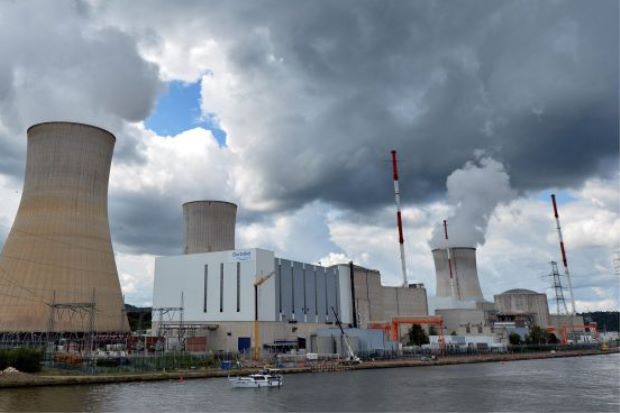Whilst Malaysia’s Prime Minister Tun Dr. Mahathir Mohammed has categorically rejected Malaysia’s adoption of nuclear power as part of its energy mix, however there are interest groups which are still lobbying the government to adopt nuclear power – purporting that since nuclear reactors do not emit carbon dioxide, believed to be a greenhouse gas, so they do not contribute to global warming.
Moreover, these lobbyists claim that nuclear power has so far been one of the safest and most efficient sources of electricity generation worldwide; despite the nuclear power plant disasters at Chernobyl in Ukraine in 1986 and the Fukushima Daiichi plant in 2011, and we add as well, the partial reactor meltdown at Three Mile Island in Pennsylvania, United States in 1979.
As of February 2019, there were about 450 nuclear power reactors worldwide producing 11% of the world’s electricity (according to the World Nuclear Association)
Nuclear is the world’s second largest source of low-carbon power (30% of the total in 2016), and over 50 countries utilise nuclear energy in about 225 reactors for research, the production of medical and industrial isotopes, as well as for training.
However, if a problem occurs, however rarely, the risks to human health and the environment can be very long term.
Malaysia’s Nuclear Background
In September 2018, Tun Dr Mahathir told the 22nd Conference of the Electric Power Supply Industry (CEPSI) 2018, that Malaysia rejected the use of nuclear power to generate electricity, and that more understanding of the power source is needed. (Source: The Malay Mail)
Tun said that this is because Malaysia had had many bad experiences with the handling of radioactive materials, and as such and called for an in-depth study, to prevent any untoward incidents from happening.
He cited the case where due to a drop in once-booming demand for tin tailings, which forced the government to negotiate with the companies to dispose of the tin waste safely, since they were found to be highly radioactive. The government ended up having to bury the tin tailings in a one-square-kilometre land.
Instead, the prime minister stated his preference for electricity generation by burning fuel, coal and other primary sources, “We have a lot of coal resources, not only in Batu Arang, but in Sabah and Sarawak as well. I think we should exploit local coal resources rather than keep importing.”
According to the Energy Commission’s Malaysia Energy Statistics Handbook 2017, Malaysia’s total electrical energy generated in 2016 was156,003 GWh (gigawatt-hours) of which 43.5% was generated using gas, 42.5% from coal, 13.0% from hydropower, 0.4% from diesel, 0.3% from oil and 0.3% from other sources (solar, biogas and others).
According to Petronas, Malaysia’s total natural gas reserves in 2016 was 87,762 trillion standard cubic feet (TSCF), whilst according to the Department of Mineral and Geosciences Malaysia, Malaysia’s total measured, indicated and inferred coal reserves as of 31 December 2016 was 1,938.37 million tonnes.
So in terms of energy security, Malaysia’s reliance on coal, natural gas and to a lesser extent hydropower for 99% of its electricity generation
Tun’s stand on nuclear power today is consistent with that of Malaysia’s government during his first 22 years as Malaysia 4th prime minister; but consideration was given towards Malaysia adopting nuclear power during the premierships of Tun Abdullah Ahmad Badawi and Dato’ Seri Najib Tun Razak.
Earlier in July 2018, Energy, Green Technology, Science, Climate Change and Environment (MESTECC) Minister Yeo Bee Yin stated that the government does not plan to build nuclear power plants or explore nuclear energy, while regulatory agency Malaysia Nuclear Power Corporation (MNPC) will be shut down soon.
She announced that the MNPC would be shut down by the end of this year (2019), making it pretty clear that nuclear-generated electricity in Malaysia is off the table for now.
Nuklear Malaysia
However, it wasn’t always so. Malaysia’s nuclear initiative dates back to the time of Malaysia’s second PM Tun Abdul Razak Hussein, when DPM Tun Dr. Ismail Dato’ Abdul Rahman proposed that Malaysia should develop development nuclear science and technology for peaceful purposes.
Following the worldwide oil crisis of the early 1970’s, the Centre for Application of Nuclear Energy (CRANE) was established in 1972 as the entity that would develop Malaysia’s nuclear programme, with a focus on manpower development for a nuclear power programme to provide an option for energy source.
The Cabinet officially approved the establishment of the Tun Ismail Atomic Research Centre (PUSPATI), under the Ministry of Science, Technology and the environment in September 1972, and the era of nuclear research in Malaysia began with the historic event signified by the Reaktor TRIGA PUSPATI reaching its first criticality on 28 June 1982.
PUSPATI was then placed under the Prime Minister’s Department as the Nuclear Energy Unit (UTN). Later the UTN came under the Minister of Science, Technology and the Environment and was renamed the Malaysian Institute for Nuclear Technology Research (MINT) on 10 August 1994.
To reflect its vision, mission, objectives and activities in the challenging world, MINT was officially renamed on 28 September 2006 as Agensi Nuklear Malaysia (NUKLEAR MALAYSIA) and was strategically located in Putrajaya, and Cyberjaya.
Nuklear Malaysia reflected the country’s progressive programme on industrialisation and manufacturing through the establishment and development of important lab facilities – such as the Non-Destructive Testing Laboratory, SINAGAMA Plant, Electron Beam Processing Service Centre, Gamma Irradiation of Rubber Latex Plant, Non-Ionising Radiation Laboratory, Secondary Standard Dosimetry Laboratory, Radioisotope Production Laboratory, Environmental Laboratory, Analytical Chemistry Laboratory, Radioactive Waste Management Centre, Flora Centre and Tissue Bank.
Via these facilities, Nuklear Malaysia intended to be a progressive national research institution enabling nuclear science and technology to assume a significant role in the national development programme.
Via these facilities, Nuklear Malaysia intended to be a progressive national research institution enabling nuclear science and technology to assume a significant role in the national development programme.
Enter the MNPC
Nuclear power deployment was included as an Entry Point project in the Economic Transformation Programme (ETP) launched on 25 October 2010 by then PM Najib Tun Razak as part of Malaysia’s New Economic Model (NEM), under the Oil, Gas and Energy sector National Key Economic Area (NKEA).
Based upon forecasts by the Economic Planning Unit and the Prime Minister’s Department, Peninsular Malaysia’s electrical energy demand will outstrip supply between 2019 and 2020, hence the need for nuclear power to fill the energy gap. 
The target back then was for Malaysia to build a twin-unit nuclear power plant with total capacity of 2 GW (gigawatts), with the first unit operational by 2021.
Shortly after the Malaysia Nuclear Power Corporation (MNPC) was established in January 2011 as a new fully dedicated nuclear energy programme implementing organisation, under the jurisdiction of the Prime Ministers Department.
It’s objectives are:-
To plan, spearhead & coordinate the implementation of nuclear energy development programme for Malaysia and to take the necessary action to realise the development of the first nuclear power plant in Malaysia;
To ensure the development of nuclear infrastructure for the country in line with International Atomic Energy Agency (IAEA) guidelines covering 19 key areas of national position, nuclear safety, management, funding & financing, legislative framework, safeguards, radiation protection, electrical grid, regulatory framework, human resource development, stakeholder involvement, site & supporting facilities, environmental protection, emergency planning, security & physical protection, nuclear fuel cycle, radioactive waste, industrial involvement, and procurement; and,
To identify the company or special purpose vehicle (SPV) to be the owner and/or operator of nuclear power plant.
The MNPC claims that equivalent fuel requirements for a 1,000 MWe (Megawatt electric) power plant are:-
2,000,000 metric tonnes of coal; 1,960,000,000 gallons of oil; 30 metric tonnes of uranium; 0.6 metric tonne of tritium & hydrogen for nuclear fusion; 100 square kilometres of photovoltaic panels at 10% efficiency; 3,000 1-MW capacity wind turbines; 30,000 square kilometres of wood for biomass; 16,100 square kilometres of corn for bioalcohol; or, 800,000,000 chickens for biogas.
MNPC cited United Nations Scientific Committee on the Effects of Atomic Radiation (UNSCEAR) figures which show that annual effective exposure to radiation per capita from nuclear power production is 0.0002 millisieverts (mSv), compared to 0.005 mSv from atmospheric nuclear testing, 0.4 mSv from diagnostic medical X-ray examinations and 2.4 mSv from natural sources.
MNPC chief executive Mohd Zamzam Jaafar told the National Transformation 2050 (TN50) conference in Sarawak that Malaysia could have its own nuclear power plant by 2030 to address the high power consumption in the peninsula.
Fast forward to today – well all that looks like it’s not going to happennow that the MNPC will be disbanded by end 2019, but Nuklear Malaysia remains.
Nuclear Waste Management
Citing figures of nuclear waste categories in France, which derives 75% of its electricity from nuclear energy, very low level radioactive waste such as earth, gravel & scrap metal from dismantling and process waste (pumps, valves and so forth) comprise around 58% of total waste by volume and emits around one-thousandth of the radioactivity.
Low-level radioactive wastes such as waste from operating nuclear installations, reactors, factories, laboratories, hospitals, waste from defence, graphite from dismantling comprise around 40% by volume and emits around 1% of the radiation.
Medium-level radioactive wastes such as ion exchange resins from reactor coolant, slurries, hulls & end fittings comprise around 2% by volume and emits around 1% of the radiation.
And, high-level radioactive wastes such as vitrified waste and irradiated fuel comprise 0.1% by volume and emits 98% of the radiation.
Three containment systems are used for low and medium radioactive waste in France where it is monitored for 300 years, after which it is reclaimed. Such storage are usually at ground level at designated sites or are buried below ground.
High radiation waste such as spent nuclear fuel are initially stored underwater in pools of water to cool, after which the fuel is enclosed in special containers which are stored in shafts in clay over 200 metres underground.
Depending on its type, the radiotoxicity of spent nuclear fuel can take between 700 to over 1,000,000 years to drop to 0.1% the radiotoxicity of natural uranium ore, and in some other countries, they are permanently sealed in tunnels in rock at depths of around 1,500 metres below ground.
The question remains, as to whether these advanced countries, let alone Malaysia, will be able to diligently ensure the safe storage of such high-level radioactive waste for such long times, and how they would manage any leaks which could develop over such long times or whether such countries and their governments and relevant agencies will be around for so long.
In the upcoming Malaysia’s Nuclear Story (Part 2), we’ll cover some lobbyists in Malaysia who are urging the government to adopt nuclear power.








